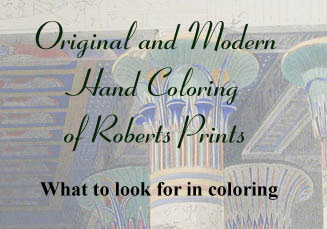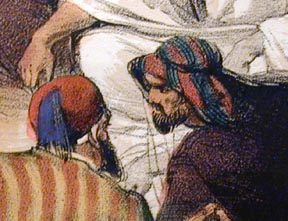


The detail at above right, from an SE print of Sebaste, Ancient Samaria colored by Medina Arts, shows quality modern hand coloring which is both true to the original RSE scheme and accurately executed. Details such as the straps of the horse's trappings and the stripes on the clothing are sharp and clear, and stay within the bounds of the lithographic lines. The colors are smoothly applied, which requires considerable technique, as the RSE paper was less absorbent than the SE paper, making large SE areas more difficult to color consistently.
 By
contrast, the detail at left from an SE Remains of a Triumphal Arch at Petra
(not performed by Medina Arts) shows coloring which follows the proper RSE
scheme but is poorly executed. While it is reasonably smooth and consistent,
it slops over into areas which should not be painted, as at the lower left of
the fez and the arm of the right figure. Colorists are often paid on a piece
work basis, and this can cause them to hurry the execution, resulting in this
kind of inaccuracy.
By
contrast, the detail at left from an SE Remains of a Triumphal Arch at Petra
(not performed by Medina Arts) shows coloring which follows the proper RSE
scheme but is poorly executed. While it is reasonably smooth and consistent,
it slops over into areas which should not be painted, as at the lower left of
the fez and the arm of the right figure. Colorists are often paid on a piece
work basis, and this can cause them to hurry the execution, resulting in this
kind of inaccuracy.
A more troubling coloring issue is acheiving the proper tints. Mosts colorists work from reproductions of RSE lithographs in one of the many books on Roberts prints. Because the printers typically do not have an RSE print on hand for reference at the time of the press runs, they usually do not color correct the printed pages to the proper hues. Blues become purples, tans become yellows, and the like. Coloring an SE print to match such a reproduction can be disastrous, greatly reducing its value.
Medina Arts maintains a substanial inventory of RSE images and photos taken directly from RSE images at the Library of Congress and the Victoria and Albert Museum. An experienced colorist with such access becomes familiar with the tints, paint colors, and techniques actually used by the original RSE colorists, and can properly transfer these to an SE print. A good colorist must have a "feel" for Roberts Prints to color the SE prints correctly. It is also important to use the proper water color pigments. Certain colors, such as cobalt blue, yellow ochre and chromium oxide green, were used extensively in the original RSE coloring and yield the correct hues. Some modern watercolors are both inaccurate and "fugitive" - i.e. not permanent. Medina Arts colorists use only water colors rated Lightfastness I, which requires no fading for at least 150 years. While this may seem extreme, bear in mind that a print can be colored only once, and the SE prints are already over 150 years old.
 The
detail at right, from an SE View Under the Grand Portico, Philae, shows
the degree of care that can be required in coloring. The sharp colored points,
the straight painted lines where appropriate, and the ability to leave the white
uncolored lines (which in this case are white paper, not white painting) are
marks of a good colorist.
The
detail at right, from an SE View Under the Grand Portico, Philae, shows
the degree of care that can be required in coloring. The sharp colored points,
the straight painted lines where appropriate, and the ability to leave the white
uncolored lines (which in this case are white paper, not white painting) are
marks of a good colorist.
Only the First Edition SE prints, made from the same lithographic stones as
the RSE prints, can be colored to match the original RSE versions. Often images
from the later, much smaller, quarto editions will be hand colored and offered
for sale. While these may be aesthetically attractive if well done, they can
never match an RSE or properly colored SE print in size, beauty and value. The
images are too small, and the lithography and paper are far inferior to the
First Editions, so as not to allow true quality coloring. The value of such
colored later editions is far, far less.